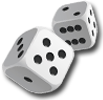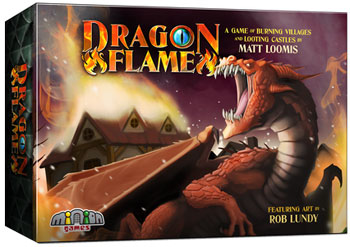



play board games
Board game reviews, strategy tips & session reports
DragonFlame Game Review
 Stats:
Stats:
No. of players: 2-5
Amount of time to play: 30-45 min
Age requirements: 13+
Set-up time: minimal
DragonFlame is a card drafting game with some hidden information, set collection and area control mechanics. And you get to be a dragon!
DragonFlame Rules Description:
DragonFlame has a deck of cards full of treasures, relics, knights, a princess and dragonflame. As a dragon you collect treasures for your hoard and burn villages with dragonflame. You start the game with three cards and fifteen flame tokens. Before you begin you must also set up the 3 x 3 grid that represents the village.
In the center of the table you place the castle cards. These cards have a number in a banner and a number in a card icon. The number in the card icon is the maximum number of cards that may be placed on that castle. The number in the banner represents the turn order for the following round.
The castle cards with a lower banner number have a lower number in the card icon. So going sooner will usually net you less cards.
On your turn you place one of your cards on a castle card that has not reached its card limit. Depending on your order in the turn and which card you are placing, the card must be placed face-up or face-down. Players that go sooner place more cards face-up.
After all players have placed their three cards in turn order you choose which castle you want. You take the castle and the cards on top of it. There is always one more castle than players. So some cards may be discarded and not taken at all.
After revealing the cards you have taken if you have any dragonflame cards you resolve them immediately, one at a time. Dragonflame cards from one to three flame icons on them. These icons represent the number of flame tokens you may place in the village. Each village card has from four to eight spots for flame tokens. You must place flame tokens in a straight line horizontally or vertically. You may only place one flame token on a village card per dragonflame card played and you must start from the outside edge of the village grid.
Relics grant you bonus powers to use throughout the game or end game powers. For example the Orb of Scrying lets you look at the hidden cards at one castle each round. Or the Amulet of Illusion lets you swap one of your treasure cards with another player’s at the end of the game.
Once there is only one card left the game ends and you total your points as follows. Some treasure cards are worth their value in VPs. Others are worth one VP for each matching treasure you have. And some are only worth VPs if you have just one of them. Knights subtract 3 VPs from your total score and the princess is worth one for each different named treasure you have. There are also curses that give you -2 VPs for each different named chest you have. You also get VPs based on the final castle banner you collected.
You also gain VPs for controlling village cards. Only village cards that are full score. And the player with the most flame tokens on a village scores the most VPs. Ties go to the player that placed their flame token first. Smaller villages only score first and second place and larger villages score first, second and third place.
You total your points and the player with the most wins.
Quick Review of DragonFlame:
Dragonflame is a fast-paced, light game that is accessible and fun. There is little down time and the game can be taught quickly.
The components for this game are nice. The flame tokens are super cute and the art is well done. The rules are pretty straight forward and easy to follow too. There are even helpful player aids to remind you of turn order and scoring.
I like the way you place cards with some face-up and other face-down. This makes the card drafting interesting and risky. And the way it all ties into the turn order is very cool.
The theme is well done and comes through. As we all know dragons love treasure and burn villages. The components add to the theme too.
I have to say the area control aspect of the game is a bit weaker than the card drafting. It can be important for winning but is not as interesting as the card drafting. And can feel like a separate mini-game.
Although the box says 13+ I played this with my 8 year old and he enjoyed it a lot. I think gamers with kids will enjoy playing DragonFlame with them. It might also be a good pick up for groups looking for a new and interesting filler to start or end game nights with.
Score and synopsis: (Click here for an explanation of these review categories.)
Strategy 3 out of 6
Luck 3 out of 6
Player Interaction 4 out of 6
Replay Value 4 out of 6
Complexity 3 out of 6
Fun 4 out of 6
Overall 4 out of 6

Leave a Reply